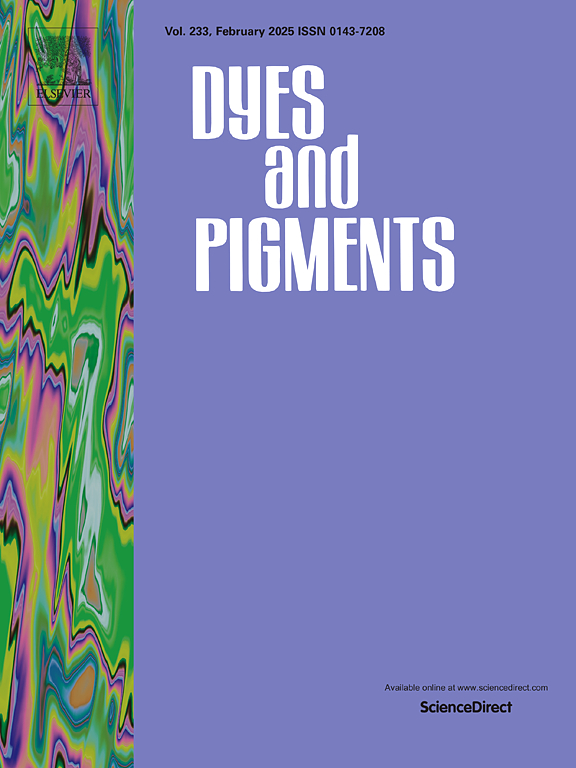Origin of abnormal fluorescence in organometallic complexes: Weak heavy-atom effect and large energy gap
IF 4.1
3区 工程技术
Q2 CHEMISTRY, APPLIED
引用次数: 0
Abstract
Organometallic complexes typically exhibit phosphorescence, which originate from the heavy-atom effect (HAE) that facilitates spin-forbidden transitions via enhanced spin–orbit coupling (SOC). However, certain complexes display anomalous fluorescence, challenging conventional understanding. Here, we investigated two representative fluorescent organometallic complexes, Per-B-Au and PMI-Pt, using time-dependent density functional theory coupled with the thermal vibration correlation function method. Our results demonstrate that the abnormal fluorescence originates from the weakened HAE and large energy gap. In Per-B-Au, the presence of bridging unit decouples the chromophore from the metal center, effectively suppressing SOC and thereby reducing the ISC rate. In contrast, PMI-Pt exhibits moderate SOC enhancement due to covalent bonding between Pt atom and chromophore. Nevertheless, the ISC rate (∼107 s−1) in PMI-Pt remains lower than the radiative decay rate (kf ∼108 s−1), which is attributed to the distinct excited-state features of the chromophore, including a large oscillator strength, an energetically lower S1 relative to T2, and a large singlet-triplet energy gap (ΔEST). Our proposed mechanism is also tenable for other reported fluorescent organometallic complexes. These findings provide fundamental insights into the luminescence mechanisms in organometallics and offer valuable guidance for designing novel fluorescent materials.
金属有机配合物中异常荧光的来源:弱重原子效应和大能隙
有机金属配合物通常表现出磷光,这源于重原子效应(HAE),该效应通过增强的自旋轨道耦合(SOC)促进自旋禁止跃迁。然而,某些配合物显示异常荧光,挑战传统的理解。本文采用随时间变化的密度泛函理论和热振动相关函数方法,对两种具有代表性的荧光有机金属配合物Per-B-Au和PMI-Pt进行了研究。我们的研究结果表明,异常荧光源于减弱的HAE和大的能隙。在Per-B-Au中,桥接单元的存在使生色团与金属中心解耦,有效地抑制了SOC,从而降低了ISC速率。相比之下,由于Pt原子与发色团之间的共价键,PMI-Pt表现出适度的SOC增强。尽管如此,PMI-Pt的ISC速率(~ 107 s−1)仍然低于辐射衰减速率(kf ~ 108 s−1),这是由于发色团的不同激发态特征,包括大的振子强度,相对于T2能量较低的S1,以及大的单重态-三重态能隙(ΔEST)。我们提出的机制也适用于其他已报道的荧光有机金属配合物。这些发现为有机金属材料的发光机理提供了基础性的认识,并为设计新型荧光材料提供了有价值的指导。
本文章由计算机程序翻译,如有差异,请以英文原文为准。
求助全文
约1分钟内获得全文
求助全文
来源期刊

Dyes and Pigments
工程技术-材料科学:纺织
CiteScore
8.20
自引率
13.30%
发文量
933
审稿时长
33 days
期刊介绍:
Dyes and Pigments covers the scientific and technical aspects of the chemistry and physics of dyes, pigments and their intermediates. Emphasis is placed on the properties of the colouring matters themselves rather than on their applications or the system in which they may be applied.
Thus the journal accepts research and review papers on the synthesis of dyes, pigments and intermediates, their physical or chemical properties, e.g. spectroscopic, surface, solution or solid state characteristics, the physical aspects of their preparation, e.g. precipitation, nucleation and growth, crystal formation, liquid crystalline characteristics, their photochemical, ecological or biological properties and the relationship between colour and chemical constitution. However, papers are considered which deal with the more fundamental aspects of colourant application and of the interactions of colourants with substrates or media.
The journal will interest a wide variety of workers in a range of disciplines whose work involves dyes, pigments and their intermediates, and provides a platform for investigators with common interests but diverse fields of activity such as cosmetics, reprographics, dye and pigment synthesis, medical research, polymers, etc.
 求助内容:
求助内容: 应助结果提醒方式:
应助结果提醒方式:


